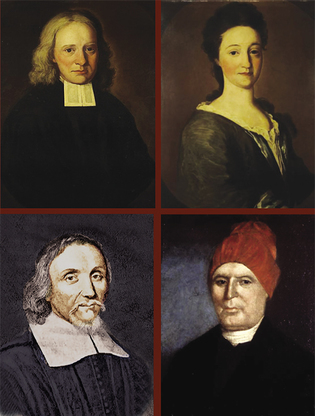
Pierponts: Yale University Art Gallery.
Clockwise from top left: James Pierpont and his wife Mary Hooker Pierpont; the pastor of New Haven’s First Church and a founder of Yale, Pierpont was a slaveholder. Alumnus Samuel Hopkins was, too, but he repented and became an antislavery activist. New Haven Colony cofounder Theophilus Eaton kept people in slavery in the seventeenth century, when it was less common in New England.
View full image
Christianity and slavery in New England
Although chattel slave-owning in seventeenth-century New England was not common, some Puritan founders of New Haven, such as Theophilus Eaton, did own enslaved persons. By the time Yale moved to New Haven in 1718, the number of enslaved persons in New England was beginning to increase significantly, and the college became inextricably linked to an economy that benefited incalculably from the importing and labor of enslaved persons.
As the number of Africans suffering in bondage in the Americas grew, blackness became associated in white minds with enslavement, and enslavement was justified by the false views that Africans were either inferior or not human, thus contributing to a system of white supremacy that would expand and deepen as time went on. But some raised questions. First, enslaved persons themselves, often in untold ways, engaged in acts of resistance from the beginning. On rare occasions, enslaved persons publicly denounced slavery, as did a man named Greenwich, of Canterbury, Connecticut, who in 1754 declared before a white congregation that he had “been instructed by the Lord” to say that “justice must take place.” As time went on, some white colonizers denounced the slave trade.
Even so, the majority feared miscegenation—the intermixing of races.
Most New England ministers defended slavery on religious grounds. For centuries, Christians had claimed there was no tension between their faith and the practice of slavery: the biblical patriarchs owned slaves, and the Apostle Paul urged slaves to obey their masters. The New England Protestants, heirs of this centuries-long tradition, helped shore up an emerging racially based defense for it. Though slavery exists in the Bible, racial slavery does not. In the late 1600s, Christians twisted a passage in Genesis to justify racial bondage. Their key text was Genesis 9, the story of Ham, who saw his father Noah’s nakedness and then faced Noah’s fury as Noah cursed Ham’s son: “Cursed be Canaan; a servant of servants shall he be.” From the time of Augustine, this passage had been used to defend slavery as the consequence of sin. Nothing in it says anything about blackness, but Protestant interpreters, eager to justify enslaving Africans, argued that Ham was the one cursed, and that one of Ham’s sons was marked with black skin.
Many Protestants defended slavery as an act of Christian compassion. The merchant John Saffin argued that enslaving Africans made possible their eternal salvation: “It is no evil thing to bring them out of their own Heathenish country.” Rev. Timothy Woodbridge, a Yale trustee, baptized an indentured Native boy named John Waubin. By Woodbridge’s logic, Waubin’s removal from his tribe was a mercy; his soul was far more valuable than his freedom.
Historically, Christians had believed the enslaved should be freed if they converted. But Protestant ministers argued that even Christian Africans should remain in bondage—a stunning reversal of Christian precedent that transformed Protestant supremacy into white supremacy. The three ministers who occupied the pulpit of the First Church of New Haven between 1700 and 1787 were all slaveholders. The first of them was James Pierpont, who secured the original charter for the school that became Yale.
The first significant cracks in the ethic of Christian slaveholding in New England came during the religious revivals of the 1730s and ’40s. Many enslaved Africans converted to Christianity, and a small number of ministers found it increasingly difficult to justify the slave trade. Samuel Hopkins, Class of 1741, was one of the first white activists to advocate immediate emancipation and the eradication of slavery. A slaveholder early in life, he had repented, manumitting a person he’d held in bondage and financially supporting him. Yet Hopkins and many others espoused sending emancipated Blacks back to Africa. In fact, New Haven and Yale would become a center of the Colonizationist movement.
Few white Christians today understand how Christians in the past failed to see that freedom is at the core of the Christian message. But there was nothing inevitable about white Christians’ eventual opposition to slavery, which came after a long and violent struggle over the meaning of the Christian faith. This struggle did not end with the Civil War. The Protestant supremacy that justified enslavement of the “heathen” turned into the white supremacy that remains with us today. Yale, like every institution with roots in early America, is entangled with this painful and lamentable Christian history.
Kenneth Minkema, executive editor of The Works of Jonathan Edwards, is a research faculty member at Yale Divinity School. Catherine Brekus ’93PhD is the Charles Warren Professor at Harvard Divinity School.
 loading
loading